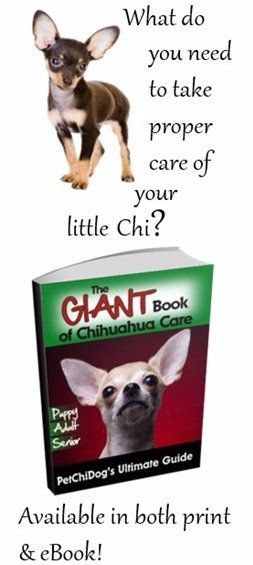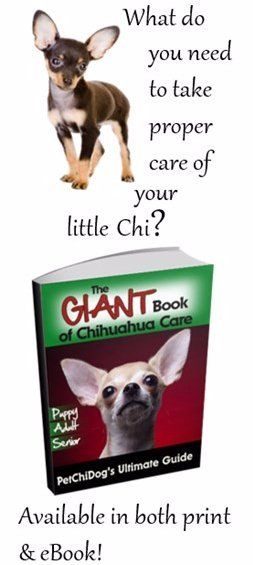Dental Care
Chihuahua Dental Care
Overview
Too many owners rely on dental treats and chews to remove plaque and tarter from their dog's teeth. Since the Chihuahua is one of the top breeds that is prone to dental problems, this can lead to somewhat serious issues.
While dental-specific treats and gnawing at certain toys will loosen some plaque, it is by no means sufficient to clean the teeth in the way that is needed to keep gums strong and keep decay at bay.
The Chihuahua breed has somewhat soft teeth. This makes the dog vulnerable to the bacteria that can cause tooth decay, infection (which begins at the gum line but can actually travel to other parts of the body) and eventual tooth loss.
By following a simple and easy at-home dental cleaning program, many potential issues can be avoided. This type of grooming care should begin as early as possible during the puppy phase; though it is never too late to begin offering good oral hygiene.
We will also take a look at the teething age, issues such as crooked teeth and double rows.
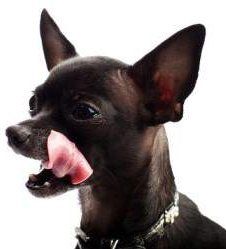

What You Should Know About the Teething Stage
Born without teeth, temporary "milk" teeth will grow in starting at the approximate age of 5 to 6 weeks. Once all have erupted, there will be 28 deciduous puppy teeth.
At about the age of 4 to 5 months, a Chihuahua puppy will begin teething. Permanent, adult canine teeth begin to grow in during this teething phase. Puppies generally lose their teeth in a certain order:
1) First the smaller front teeth come out
2) Then the premolars
3) Molars are next
4) Finally the large canine teeth come out
Often, a puppy's milk tooth will fall out while eating or playing. Since a pup's tooth is very small, it is often swallowed before an owner notices that it has fallen out. Sometimes there will be a small amount of blood, but usually this is not noticed as well as the pup quickly swallows it as well.
When the teething
process is complete, the Chihuahua will then have 42 permanent teeth.
Double Rows
It is not uncommon for a Chihuahua to have double teeth. This happens when a milk tooth stays in place while the adult canine is erupted. With the milk tooth blocking its normal path, the adult canine will emerge just behind the smaller one. Since this was not the natural path, it it often crooked or slanted off to one side.
This can often be avoided by examining the mouth every week, beginning at the age of 3 months until teething is complete. If spotted early enough, the very small (and lightly rooted) milk tooth can easily be removed by an experienced veterinarian. Once it has been extracted, the larger adult tooth will generally move back into its proper place as it continues to emerge.
Proper Bite
Many owners wonder what type of bite set the Chihuahua breed should have. In the U.S., per AKC breed standards, the Chihuahua may have either a scissors bite or a level bite.
- A scissor bite is one in which the incisor teeth in the upper jaw are in contact with but slightly overlap those in lower jaw
- A level bite is very similar; however the incisor teeth meet exactly, surface to surface. The upper incisors will not overlap those in the lower jaw even slightly.
While both are acceptable bite for the breed, it should be noted that dogs that have a level bite are prone to more dental problems. The reason for this is because with a level bite, the teeth tend to wear down more quickly.
These Chihuahua will need to be monitored more often than those with a scissor bite; though both do require at-home dental brushing and at-home or professional scrapings.
Misaligned Bite
Problems can occur if a Chihuahua has a moderate to extreme undershot or an overshot jaw. With minor misalignment, not much will need to be done though the teeth will need to be monitored.
More serious problems may require some teeth to be removed and possible jaw surgery. This includes:
A Wry Mouth -
This refers to when one side of the mouth is much longer than the other or the jaws are out of alignment. It can cause pain in the mouth, problems with eating
and leave teeth very vulnerable to infection.
Malocclusion -
An issue that does not affect the jaws at all, however the teeth themselves are moderately to severely crooked teeth). There are 2 main causes for this:
1)
Genetics - This is thought to be an inherited fault for some Chihuahuas. Though, with proper breeding practices, a Chihuahua with malocclusion should not be bred.
2)
Premature detachment of the puppy's milk teeth. Adult canine teeth follow the trail of the wispy thin roots of the milk teeth as the path in which to emerge.
If milk teeth detach before they fall out naturally, this causes an issue in which those adult canines do not have a clear path to erupt. They will then surface at random, odd, and slanted angles which can cause a mouthful of crooked teeth.
For this reason, it is important to refrain from any action that would interfere with the puppy's teeth. It is highly recommended to not play 'Tug of War' or any game with a toy that will tug at the small milk teeth.
Why Dental Care is So Important For Your Dog
As discussed in our
age section, not very long ago, people did not think a lot about their dog's teeth. It was thought that when a dog chewed on dry, hard dog food, this scraped the teeth clean. It was also believed that when a dog chewed on rawhide treats or hard toys this also cleaned the teeth.
While these types of things will clean the dog's teeth to some degree...the canine medical world has learned that this is not nearly enough.
The Chihuahua breed is prone to tooth decay and infections. There are some easy steps that an owner can take to help keep their Chi's teeth strong and healthy:
1)
Begin at-home brushing as early as possible. A puppy will need to have his teeth brushed even though they will be replaced during the teething phase. Without proper cleaning, infection can travel from a milk tooth to a recessed adult tooth that has yet to emerge. In addition, brushing keeps the gums strong and healthy, and the gums are the foundation for a strong set of teeth.
2)
Use a quality canine toothbrush and quality canine toothpaste.
3) Use quality dental chews as a supplemental method of cleaning the teeth. They do work to a certain degree to loosen plaque and freshen breath. The right chews are an important part of good oral hygiene.
How to Brush a Chihuahua's Teeth
Dental cleanings should be a scheduled part of each day. Just as you brush the coat, take your Chi for a walk for
exercise, play, feed him healthy meals and have a set sleep time, you should also take 5 minutes out of the day to clean your Chihuahua's teeth.
Here are some tips for successful, easy cleaning:
1)
This is best done with a canine toothbrush, made for toy breed dogs. Do not use a human toothbrush as it is not shaped to properly reach the surfaces of a dog's set of teeth. Never use human toothpaste; It is toxic to dogs (in varying quantities and depending on the age and size of the dog) and since much of the paste will be swallowed you will want to make sure that the substance is safe for consumption.
2)
Choose a certain time of the day for this. In this way, it will become habit for both you and your Chihuahua. While it only takes about 2 to 3 minutes for the actual brushing of the teeth, it is best to set aside a window of 10 minutes per day so that you do not feel rushed.
3)
Have a good grip on your Chihuahua, as those that are not used to having their teeth touched will tend to try and scamper away. It can help to have an assistant, however if you curl your puppy or dog up in your lap this can usually work just fine.
4) If you relax, your Chi will relax. Speak in a matter-of-fact tone and do not be shy to manipulate the mouth. Puppies that have their mouths opened and teeth touched will be adults that are tolerant to this sort of grooming element.
5)
Be sure to brush on all exposed sides of the teeth: Front, back and tops. Scrub the back teeth as much as the front, using a circular motion that is slightly angled to scrub at the gum line.
6)
Once all teeth are cleaned (2 minutes or so), wipe the mouth with a damp, soft washcloth and give praise even if your Chihuahua struggled and tried to escape the whole time. A dental chew can be a good reward treat when the task is complete.
7)
Remember that with time, your Chihuahua will react to tooth brushing as a normal part of his day. Most puppies and dogs simply accept this and will begrudgingly sit still while the task is performed.
Intolerance for Brushing
For puppies that have no tolerance at all for having their mouths opened and teeth brushed, owners will need to ease into the process in a more gradual way.
It can help to allow your Chihuahua to become accustomed to the feeling of having his teeth touched
.
1)
Moving your finger around on the teeth can help him or her get become accustomed to having something in his mouth that is not a tasty treat
or dog toy.
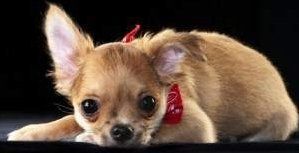
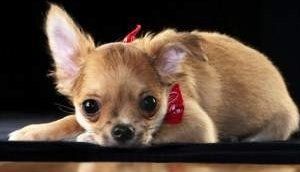
2)
After a few weeks, you can then try the toothbrush.. It is recommended to use it for a few days with no paste. As your Chihuahua gets used to the feeling, you can slowly add more and more canine toothpaste. Before you know it, your dog will accept this as a normal part of his day.
3)
If your dog is extremely stubborn and refused to let you near him with a toothbrush, you can use the 2nd best method: dental wipes. While these will not do as thorough of a job, it will hold some benefits.
Snacking and Treats
Crunching on hard treats and chews does have its benefits. It helps to loosen plaque so that it can be removed easier during cleanings.
Here are some tips on choosing the right dental chews:
1)
Avoid products that contain artificial colors, flavors or byproducts since the Chihuahua breed is known for having a high sensitivities to these sorts of man-made chemicals and by-products are low quality ingredients for a dog to ingest.
2)
Look for brands that contain wholesome, natural ingredients such as dill, mint and parsley which work in combination to not only clean teeth, but to rid a dog of bad breath.
Note:
If you are not happy with the products that you are using or if you wish to see recommended fresh breath chews, brushes and pastes, you may wish to look under 'Dental' in the Chihuahua Specialty Shoppe.
Professional Cleanings and Scrapings
Your dog's veterinarian will usually also be your dog's dentist. It is important to have a dental checkup once a year. The Chihuahua breed is sensitive to anesthesia and this is usually used to sedate a dog during a "full dental; in which tarter is scraped off the teeth and under the gum line. X-rays are taken and a rinse is done as well.
You will want to speak with your Chihuahua's veterinarian to discuss your particular dog and whether or not sedation is right for him or her. Even if it is determined that sedation should not be used, the vet will still be able to do an examination to detect any possible issues that will then need to be resolved. This includes looking for cracked teeth, loose teeth and signs of infection.
Red Flags
Too often, owners do not realize that there is a tooth problem with their dog until it is grown severe. Even if you are performing regular brushings and offering healthy dental chews, be sure to keep an eye out for potential issues.
Some common signs that there is something wrong with a tooth are:
Bad Breath -
It is not normal for a dog to have terrible breath. This can point to not only dental issues but a range of other health problems as well. In some cases, simple at-home remedies can resolve the problem. Read more:
Chihuahua Bad Breath.
Bleeding -
Blood flow from the mouth is never normal. Even with teething, blood will be so minimal that it is rarely noticed.
Reluctance to Eat -
Usually nothing can stop a hungry Chihuahua and you'd better not get in the way of a Chihuahua and his meal. When this breed refuses food or picks slowly away at it, this is almost always points to some sort of health issues and problems with a tooth is high on that list.
We are a participant in the Amazon Services LLC Associates Program, an affiliate advertising program designed to provide a means for us to earn fees by linking to Amazon.com and affiliated sites.
Email: Contact@PetChiDog.com

